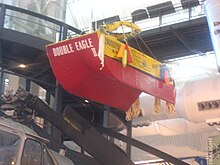Double Eagle II
The Double Eagle II , piloted by Ben Abruzzo , Maxie Anderson and Larry Newman , was the first balloon to cross the Atlantic . It landed on August 17, 1978 in Miserey near Paris , 137 hours and 6 minutes after taking off from Presque Isle in the US state of Maine .
prehistory
In 1844, the American writer Edgar Allan Poe attracted public attention when he claimed in his balloon hoax in the New York Sun newspaper that balloonist Monck Mason had flown over the Atlantic. The first serious attempt at overflight was made in 1873 by the well-known Civil War balloonist John Wise . After the start in New York City , however, it was brought to the ground by a storm over the Catskills . In the 1970s, the old dream was revived as a new generation of aeronauts looked for new challenges. Flying a balloon across the Atlantic, however, was no easy task. Before the success of the Double Eagle II , a total of seventeen attempts were made, with seven people killed.
The last attempt before the Double Eagle II was made in July 1978 by two Englishmen who were flying from St. John's on Newfoundland . They missed their destination, Brest , France, by only 103 miles. Ben Abruzzo and Maxie Anderson themselves had tried in September 1977, but were forced to the ground by bad weather off the coast of Iceland . Your balloon for this attempt was the Double Eagle .
Atlantic overflight
Ben Abruzzo, Maxie Anderson and Larry Newman, all from Albuquerque , New Mexico , made the 3,100-mile flight from Presque Isle, Maine, to Miserey near Paris in 137 hours and 6 minutes. The start took place on August 11, 1978 at 8:42 pm. Her helium- filled balloon, the Double Eagle II , was 112 feet tall, 65 feet in diameter, and had a capacity of 160,000 cubic feet. The gondola, called The Spirit of Albuquerque , measured 15 x 7 x 4½ feet and was equipped with a catamaran that would float in the event of a ditching . Also carried by Newman, a hang-glider and owner of a kite manufacturer, was a glider that was attached to the gondola. The idea was to use it for the descent at the end of the flight. However, it had to be dropped to relieve the balloon before the crew reached their destination.

The Double Eagle II was built by Ed Yost from Tea , South Dakota , who had attempted a transatlantic attempt himself in 1976. The gondola was equipped with computers for navigation and radios to communicate with surveillance stations on land. It had a VHF radio, two single sideband radios, an ADF transmitter, an amateur radio , a marine radio and a connection to the Nimbus 6 satellite , which transmitted its latitude and longitude to the Goddard Space Flight Center in Maryland .
The Atlantic crossing was officially achieved on August 16 at 10:02 p.m. when the Double Eagle II crossed the Irish coast . However, the destination of the three pilots was Le Bourget Airport near Paris, where Charles Lindbergh had landed. But in the late afternoon of August 17th, with low ballast and waning daylight, the pilots decided to land in Normandy . So they came down in a wheat field near Miserey at 7:48 p.m. and were immediately surrounded by crowds who had followed the balloon path.
During the overflight, the Double Eagle II fluctuated from a dangerous low of 3,500 feet on August 13, when clouds blocked the sun and cooled the gas, causing the balloon to descend, to a maximum of 24,950 feet on August 16.
Whereabouts
The balloon gondola is now in the Steven F. Udvar-Hazy Center of the National Air and Space Museum in Chantilly, Virginia .
literature
- National Geographic Magazine , No. 6, Vol. 154, December 1978
Web links
- The gondola in the National Air and Space Museum (English)
- Maggie Turqman: The First Successful Balloon Flight Across the Atlantic , Nat Geo Education Blog, July 31, 2014 (English)
- Sarah Levy: The Curse of Heaven . one day , July 21, 2012.
